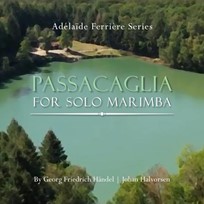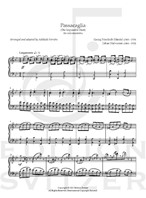
Passacaglia
Composer: Georg Friedrich Händel
Instrument: Marimba
Level: Advanced
Published: 2021
Price: €16.00
Item details
-
Description +
-
Duration: approx 9 min.
Arranged and adapted by Adélaïde FerrièrePreface
« This arrangement is made of the “Passacaglia” from the “Suite in G Minor HWV 432” by Handel for solo piano combined with “After the Harpsichord Suite in G Minor HWV 432” written by Johan Halvorsen, also known as “The Impossible Duet” for Cello and Violin. »
Adélaïde Ferrière
-
-
Instrumentation +
-
Marimba (5-octave)
-
-
Watch+
-
Performed by Adélaïde Ferrière
-
-
About the composer +
-
George Frideric (or Frederick) Handel was a German, later British, Baroque composer who spent the bulk of his career in London, becoming well known for his operas, oratorios, anthems, and organ concertos. Handel received important training in Halle and worked as a composer in Hamburg and Italy before settling in London in 1712; he became a naturalised British subject in 1727. He was strongly influenced both by the great composers of the Italian Baroque and by the middle-German polyphonic choral tradition.
-
-
Reviews +
-
Review (Percussive Notes, February 2022)
This adaptation for solo marimba by virtuoso Adélaïde Ferrière is a combination of the “Passacaglia” from the Suite in G Minor HWV 432 for solo piano by Händel and Johan Halvorsen’s After the Harpsichord Suite in G Minor HWV 432 for cello and violin.
“Passacaglia” is recommended for advanced and professional players. Upon listening to the work, I was shocked it is even possible! There are numerous examples of small intervallic changes, expansive use of the instrument’s range, dense rhythmic passages between the hands, intricately articulated gestures, and much more.
Two segments of the piece stood out for their virtuosity. The first, marked at quarter note equals 80 bpm, requires the player to simultaneously play a mix of arpeggiated and stepwise thirty-second- note lines with a steady eighth-note passage above it. The second, written in similar fashion, uses sextuplets, small interval changes, and thick chromaticism in both hands over large portions of the upper register.
A truly Herculean task, Ferrière’s “Passacaglia” is a beautiful addition to her ever-growing body of work and would be impressive on any solo recital.
—Danielle Moreau
-
-
Credits +
-
Front Cover Design: Nicola Lee
Photo: Adrien Roux
Engraving: Adélaïde Ferrière
Printed in Copenhagen,
Denmark www.editionsvitzer.com
-





